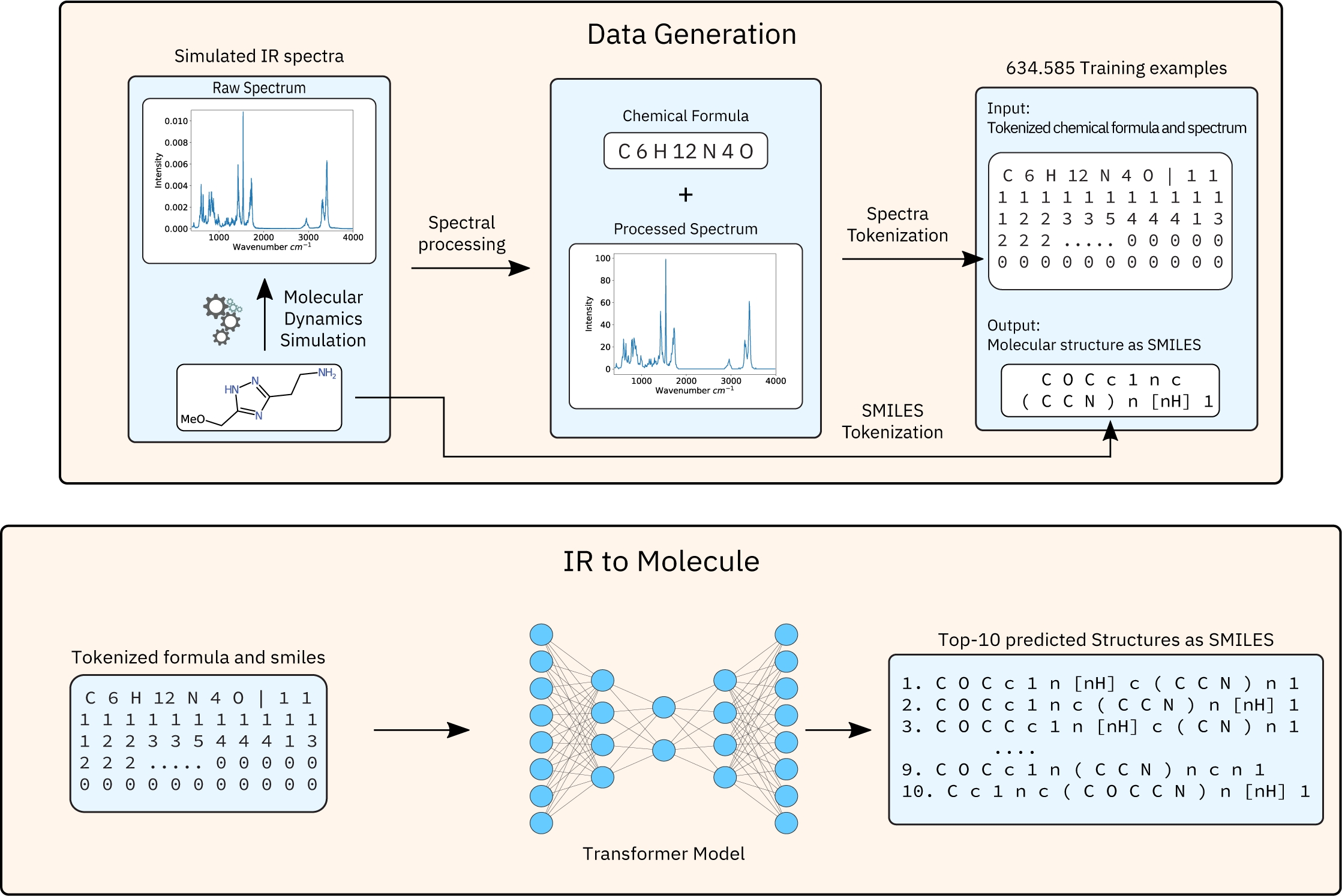Scripts of the paper: Leveraging Infrared Spectroscopy for Automated Structure Elucidation.
The dataset generated in this paper and on which all models were trained is available at: 10.5281/zenodo.7928396
Create a conda environment for the scripts:
conda create -n irtomol python=3.9
conda activate irtomol
conda install -c conda-forge lammps
Install all dependencies:
pip install -r requirements.txt
EMC can be downloaded from here. Version 9.4.4 was used for all simulations. To setup EMC, add both bin and scripts to your PATH by running the commands below. Set EMC_ROOT environment variable to the path of the EMC folder (e.g. ~/emc/v9.4.4):
export EMC_ROOT=<path to EMC folder>
export PATH=$PATH:$EMC_ROOT/bin:$EMC_ROOT/scripts
This section explains how to generate IR spectra using a molecular dynamics pipeline. The code requires both EMC and LAMMPS.
Running the pipeline requires a csv file with two columns: 'Indices' and 'Smiles'. The pipeline will create a separate folder for each row and runs the simulation for a given smiles in this folder. The name of the folder is a vale as specified in the column 'Indices'. This allows you to correlate a SMILES with a simulation folder once all simulations have finished. If the column 'Indices' is not present the script will use the number of the row.
Both the emc_template.esh and the lammps_template.in can be found in scripts/mol_dyn/.
python scripts/run_md_pipeline.py --smiles_csv <smiles_csv> --output_folder <output_folder> --field <force field> --steps <steps> --cores <cores> --emc_template <path to emc_template.esh> --lammps_template <path to lammps_template.in>
To test the script, run the following command with the example.csv provided:
python scripts/run_md_pipeline.py --smiles_csv examples/smiles.csv --output_folder examples/out --steps 50000 --emc_template scripts/mol_dyn/emc_template.esh --lammps_template scripts/mol_dyn/lammps_template.in
Note: For reliable spectra, do not run production runs with 50,000 steps; 500,000 is more appropriate.
Once the simulation pipeline has finished, you can gather the data using the gather_ir_data.py script. Provide the script with the simulation_folder, the smiles_path (path to the smiles csv used for the simulations) and where to save the data (output_folder, saved as a pickled dataframe ready to train with).
For the example run as follows:
python scripts/gather_ir_data.py --simulation_folder examples/out --smiles_path examples/smiles.csv --output_folder examples/
This section covers preparing the data for the model, training the model, running inference and scoring the output of the model.
The prepare_data.py script creates the input data from the simulated data. It requires as input a pickled dataframe with the columns: 'formula', 'spectra' and 'smiles'. The spectra is expected as a 1D Numpy array with a range from 400-3982cm-1 and a resolution of 2cm-1 (i.e. 1792 values).
Parameters of the script:
--data_path: Path to the pickled dataframe
--output_folder: Path where the processed data is saved
--n_tokens: With how many tokens the spectrum is encoded (default 400)
--window: What window of the IR spectrum is used, Options: full: Full spectrum, fingerprint: 400-2000<sup>-1</sup>,
umir: 400-3982<sup>-1</sup> and merged: 400-2000<sup>-1</sup> with 2800-3200<sup>-1</sup>
--augmentation: Augmentation options, Options: N/A, smooth, shift_horizontal, noise_vertical, all (only smooth
and shift_horizontal)
--special: Special data preparation, Options: N/A, Formula: only the formula, Spectrum: only the spectrum
Running the script to generate training data from the example:
python scripts/prepare_data.py --data_path examples/ir.pkl --output_path examples/train
Run a training of the model using the run_training.py script. This script requires a directory prepared by the prepare_data.py with a subfolder called data which contains the training, validation and test data. Another requirement is a path to a OpenNMT configuration template. The template with which all trainings were performed in the template is provided in scripts/transformer_template.yaml.
For the example try:
python scripts/run_training.py --template_path scripts/transformer_template.yaml --data_folder --data_folder examples/train
Note: The template expects a GPU to be present and to run a real training much more data is required.
For testing purposes, training a model for only few steps with a tiny model on CPU only:
python scripts/run_training.py --template_path scripts/transformer_template_tiny_cpu.yaml --data_folder --data_folder examples/train
Run the following command to do inference:
onmt_translate -model <model_path> -src <src_path> -output <out_file> -beam_size 10 -n_best 10 -min_length 5 -gpu 0
For the example (dummy model, valid set, CPU only), this corresponds to the following:
onmt_translate -model examples/train/model_step_5.pt -src examples/train/data/src-val.txt -output examples/train/pred-val.txt -beam_size 10 -n_best 10 -min_length 5
Scoring can be done via the score.py script:
python scripts/score.py --tgt_path <path to tgt file> --inference_path <out file from inference>
For the example above:
python scripts/score.py --tgt_path examples/train/data/tgt-val.txt --inference_path examples/train/pred-val.txt
Use --n_beams if the beam size is changed from 10 during inference.
